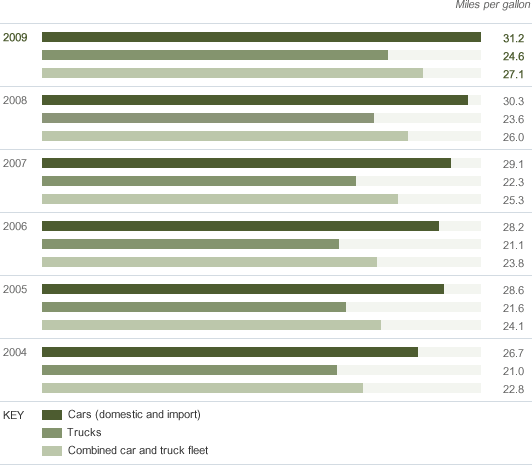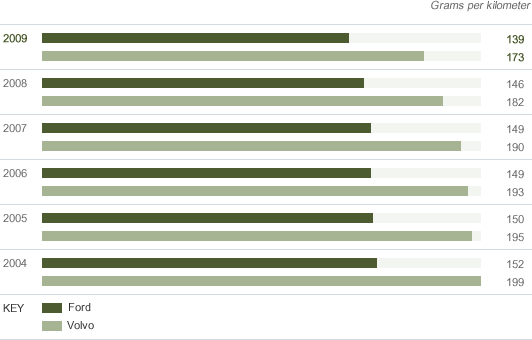Toolbox
Fuel Economy and CO2 Emissions
Data On This Page
A. Ford U.S. Corporate Average Fuel Economy

| 2004 | 2005 | 2006 | 2007 | 2008 | 2009 | |
|---|---|---|---|---|---|---|
| Cars (domestic and import) | 26.7 | 28.6 | 28.2 | 29.1 | 30.3 | 31.2 |
| Trucks | 21.0 | 21.6 | 21.1 | 22.3 | 23.6 | 24.6 |
| Combined car and truck fleet | 22.8 | 24.1 | 23.8 | 25.3 | 26.0 | 27.1 |
For the 2009 model year, the Corporate Average Fuel Economy (CAFE) of our cars and trucks increased by 4.2 percent relative to 2008. Preliminary data for the 2010 model year show a 3.2 percent improvement in CAFE for cars and a slight decline of 2.4 percent in CAFE for trucks as compared to 2009. For more information, please see Fuel Economy and Greenhouse Gas Emissions.
- Reported to regulatory authorities
In This Report:
B. Ford U.S. CO2 Tailpipe Emissions Per Vehicle (Combined Car and Truck Fleet Average CO2 Emissions)

| 2004 | 2005 | 2006 | 2007 | 2008 | 2009 |
|---|---|---|---|---|---|
| 387 | 368 | 371 | 352 | 340 | 326 |
Improvement is reflected in decreasing grams per mile.
In 2009, Ford reduced U.S. CO2 tailpipe emissions per vehicle for the third year in a row. See the Climate Change section for a discussion of our CO2 emissions performance.
In This Report:
C. Ford Europe CO2 Tailpipe Emissions Per Vehicle

| 2004 | 2005 | 2006 | 2007 | 2008 | 2009 | |
|---|---|---|---|---|---|---|
| Ford | 152 | 150 | 149 | 149 | 146 | 139 |
| Volvo | 199 | 195 | 193 | 190 | 182 | 173 |
Improvement is reflected in decreasing grams per kilometer. European and U.S. fleet CO2 emissions are not directly comparable because they are calculated in different units and because they are assessed based on different drive cycles. In 2009, we switched from reporting European vehicle CO2 emissions as a percent of a 1995 base to reporting actual fleet average CO2 emissions, to parallel our reporting for other regions.